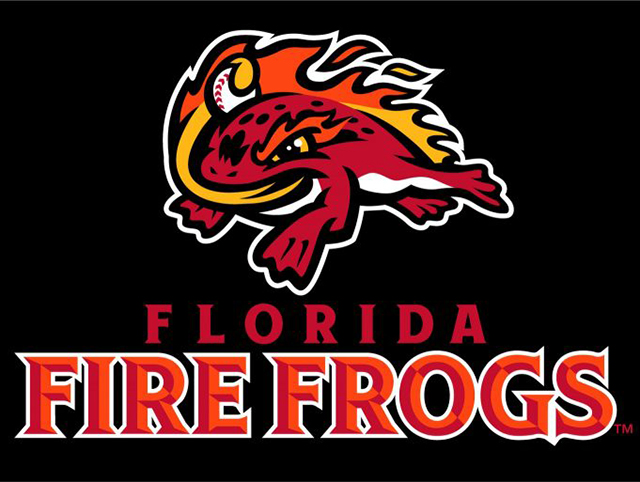
The first half of the inaugural season for the Florida Fire Frogs came to a close after a 2-1 win over the Daytona Tortugas on Monday, June 12, though the team didn’t know it yet. Rain and lightning would end up causing the cancelling of the remaining two games of the series against Daytona and the Fire Frogs would close out the first half with a 25-38 record, the worst mark in the Florida State League and 9 games out of first.
It’s an inauspicious debut for the Braves high-A team, which was hampered by injuries to key players and the early promotions of several top performers.
Other Braves’ Minor League Affiliate Reviews:
Rome Braves (A)
OFFENSE
The Fire Frogs were fourth in the FSL in on-base percentage (.329) and third in slugging (.379). A robust offense was expected coming out of spring training with several of the top position player prospects in the Braves system on the squad, including slugging third baseman Austin Riley, outfielder Ronald “The Answer For Everything” Acuna, and newly acquired converted catcher Alex Jackson. They were joined by players that were coming off a championship run for the A-level Rome Braves in 2015, including outfielders Ray-Patrick Didder and Tyler Neslony, first baseman Carlos Castro, catcher Jonathan Morales, and shortstop Alejandro Salazar. Infielder Omar Obregon and outfielder Braxton Davidson were holdovers from the former incarnation of the Braves high-A team, the Carolina Mudcats.
From the beginning of the season through May 8, the Fire Frogs scored an average of 5.4 runs per game. After May 8 however, the Frogs only scored 3.5 runs per game. May 8 of course was the last Fire Frogs game with Acuna, who was promoted to AA Mississippi. Within a few days, the Frogs would also be without Jackson and Castro, both of whom missed significant time after getting hit with pitches. While outfielder Anfernee Seymour came up from Rome to replace Acuna in center field and has provided a .389 on-base percentage and outfielder Tyler Neslony hit well while being pressed into duty at first base for Castro, simultaneous and extended slumps by Riley and Morales have proved too much to overcome.
Castro has since returned to duty and Jackson is reportedly just a couple weeks away. There’s also a chance that the offense could be bolstered by the promotion of Rome catcher Brett Cumberland, a 2016 college draftee who is leading the South Atlantic League with a 171 wRC+.
Fire Frogs Leaderboard (wRC+, minimum 120 plate apperances )
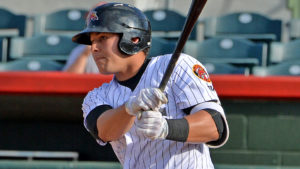
- Alex Jackson* – 169
- Tyler Neslony* – 153
- Ronald Acuna – 134
- Anfernee Seymour – 124
- Carlos Castro* – 123
- Braxton Davidson* – 112
- Austin Riley* – 109
- Ray-Patrick Didder – 94
- Omar Obregon – 89
- Alay Lago – 89
- Jonathan Morales – 75
- Alejandro Salazar – 71
* – All-Star selection
STARTING PITCHING
Starting pitching has overall been a strong point for the Fire Frogs, with two starters, left-handers Tyler Pike and Drew Harrington, selected for the FSL All-Star Game. A third lefty, Luiz Gohara, would likely have joined them if he hadn’t been promoted to AA Mississippi prior to the announcement.
Just slightly off the pace set by those three is former Rome left-hander Ricardo Sanchez. Sanchez has given up 2 or fewer earned runs in 7 of his 12 starts. Finally there is prospect Touki Toussaint, who is having a bit of an odd season. Toussaint is setting career bests in both strikeout and walk rate and is also generating career high groundballs. These fact should be a recipe for success, but the results have been a 5.77 ERA. In a recent interview, Toussaint indicates that he’s been working on a sinker heavily, so it may be getting used to that new pitch.
Gohara’s spot in the rotation was taken by journeyman right-hander Enderson Franco, who owns an 8.46 ERA in six starts.
Going forward, the Frogs will have to continue without Tyler Pike, who has followed Gohara to Mississippi. Considering how aggressive the Braves have been with starting pitcher promotions, it would not be shocking if any of Toussaint, Sanchez, or Harrington followed at some point in the second half. Right-hander Alan Rangal was just promoted to Florida, but it’s unclear if that’s a permanent assignment as Rangal is only 19 years old and was just moved up to Rome a week and a half ago. Ryan Lawlor would seem to be the logical choice to move up next given that he has already experienced high-A and was pitching well before a recent injury. Jeremy Walker may also be a promotion possibility from Rome. In all of these cases, it would likely weaken the Frogs rotation.
Fire Frogs Leaderboard (xFIP, minimum 5 games started )
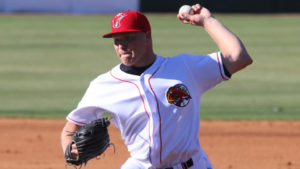
- Luiz Gohara – 2.54
- Drew Harrington* – 3.31
- Tyler Pike* – 3.39
- Touki Toussaint – 3.44
- Ricardo Sanchez – 3.58
- Enderson Franco – 4.97
* – All-Star selection
RELIEF PITCHING
Despite a few superlative individual performances, the Fire Frogs bullpen overall has been fairly bad in the first half, pitching to a 4.43 ERA. A lot of these problems occurred in the first month of season and was the main reason why the team only went 13-17 through May 8 despite scoring that 5.4 average runs per game. By the time the bullpen stabilized, the offense started to fizzle.
The bullpen is lead by right-hander Devan Watts, who has been outstanding at three levels since the Braves drafted him in the 17th round of the 2016 draft out of Tusculum College. In fact, Watts can lay claim to the strongest bullpen performance in the entire Braves farm system so far in 2017 with a 1.46 ERA and 32 strikeouts in 24.2 innings.
Watts has been supported by two tough left-handers, Chase “The Mountain That Pitches” Johnson-Mullins and Corbin Clouse. Johnson-Mullins has struck out 31 in 29 innings, but has mostly been successful by inducing groundballs, currently at nearly a 68% rate. Clouse got off to a terrible start, surrendering 9 earned runs in his first 5 outings. Since then he has gone 12 consecutive outings without allowing an earned run, 18 innings total during that stretch.
Right-hander Jacob Webb has also gotten strong results in his first full season since undergoing Tommy John surgery that wiped out his entire 2015 season and half of 2016. Webb has strikeout stuff and has limited batters to a .171 batting average against, but does occasionally run into problems with his control.
Right-handers Sean McLaughlin, Taylor Lewis, and Josh Graham have rounded out the bullpen, and this trio has struggled the most. McLaughlin’s 4.25 ERA in 29.2 innings doesn’t look great, but like Clouse most of the damage was done early in the season. Lewis on the other hand has struggled pretty much all season, pitching to a 8.87 ERA and struggling mightily with control, walking 5.64 per 9 innings. This has been a surprising development after Lewis had a very strong season at the same level in 2016 and even got a late season promotion to AA. Graham has struggled with control, walking two more batters per nine innings this year over his strong 2016 campaign with Rome.
The Fire Frogs have also gotten 14.2 unmemorable innings from journeyman Andres Santiago, 4.1 innings from the since-released Carlos Salazar, and 2 innings from A.J. Minter, along with various pitchers passing though on rehab assignments.
While the bullpen has been a sore spot for the team in the first half, there is potential for it to be a point of strength in the second half. There could also be reinforcements coming up from Rome, where the bullpen has been largely excellent this season.
Fire Frogs Leaderboard (“Goose Eggs“)
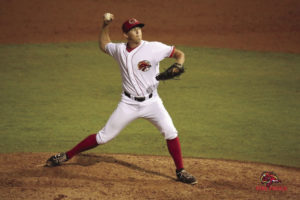
1. Devan Watts* – 11
2(t). Chase Johnson-Mullins – 7
2(t). Jacob Webb – 7
4. Sean McLaughlin – 6
5. Josh Graham – 5
6(t). Corbin Clouse – 3
6(t). Mauricio Cabrera (rehab) – 3
8(t). Taylor Lewis -1
8(t). A.J. Minter – 1
* – All-star selection
Note: Since “goose eggs” are a new thing, I feel free to modify it to my whim. My criteria for being credited with a goose egg are:
- The reliever pitches a scoreless inning from the 7th inning on.
- The game score is tied, the reliever’s team is leading by no more than two runs, or the reliever’s team is trailing by no more than one run.
DEFENSE
Advanced metrics for minor league defense are virtually non-existent and amateur scouting is difficult due to the Florida State League not streaming their games on the Internet (well, I almost made it through a post about the Fire Frogs without bringing that up, perhaps I am growing as a person), so we’ll have to rely on good-‘ole error and fielding percentage data.
First off, that data tells us that first base defense has been brutal. Carlos Castro has 7 errors and a .981 fielding percentage, which is not good, but is practically Joey Votto-esque compared to the butchery that was Tyler Neslony playing first base. To be fair, Neslony is an outfielder by trade and was pressed into service. Neslony has also been extremely productive at the plate. That said, if Castro does have to miss time again, hopefully the Braves will find another solution besides moving Neslony back to first.
The middle infield defense likewise has been subpar, which is a little surprising given the solid (and occasionally spectacular) shortstop play of Alejandro Salazar in Rome last season. With 11 errors already, Salazar isn’t far from surpassing last year’s total of 14. Second base has been primarily manned by Mexican import Alay Lago, who has been solid if unspectacular, as has bench infielder Omar Obregon. Ray-Patrick Didder, who was signed as an infield out of Aruba but played only outfield in 2016, has returned to second base for 5 games and shortstop for 3 games and has been pretty good. If Didder can prove himself as capable of both infield and outfield positions, he will greatly enhance his chances of someday being a major league bench option.
The one infield position that has exceeded expectations is third base, where Austin Riley has been much surer-handed this season, only committed 5 errors on the season. To put that in perspective, Riley had committed 14 errors at this same point last season, on his way to tallying 30 on the season and giving prospect gurus more cause to believe a position change to the outfield or first base was inevitable. Being able to stick at third base would greatly enhance Riley’s value.
Outfield defense has mostly been strong, with Braxton Davidson in particular handling the move from right field to left with some aplomb. Anfernee Seymour switched back to the outfield this offseason after being made an infielder in the Marlins system and has looked overall more comfortable; his routes are more erratic than Acuna’s, but his speed allows him to usually haul most balls in.
Of course the most interesting defensive question has been how Alex Jackson has taken to catching. By the rudimentary numbers available, the answer seems to be “OK”. He’s committed 6 errors in 17 games and only has a 23% caught stealing rate, but I would consider those numbers adequate for a player returning to the position as a pro three seasons after playing it in high school. Jonathan Morales has spent more time behind the plate and has 5 errors and a 32% caught stealing rate.
SUMMARY
The Fire Frogs got smoked in the first half. There were many factors involved in this, most notably: the promotions of Ronald Acuna and Luiz Gohara to Mississippi; the injuries to Carlos Castro and Alex Jackson; generally poor bullpen work, especially early in the year; the poor performance of Touki Toussaint despite good peripheral metrics; and generally poor infield defense.
The good news is that Castro has returned and Jackson should soon follow. There is reason to believe the bullpen has mostly righted itself. In his two starts in June, Toussaint has allowed only 2 earned runs in 12.2 innings pitched. These trends can drive the Fire Frogs to a better second half record.
Will they be enough for the Fire Frogs to complete a worst-to-first mid-season turnaround as Rome did last season? Honestly, it seems unlikely. As prospect-laden as the Frogs are, there are other teams at this level like Clearwater (Phillies), Tampa (Yankees), and Daytona (Reds) that can match them at this level. Also the Braves organization itself is an impediment, which seems to view the high-A level more than any other as a quick stopping point for top prospects that are performing well. If any Fire Frogs start showing significant signs of progress, there’s a very good chance they could be moved up to Mississippi during the season.


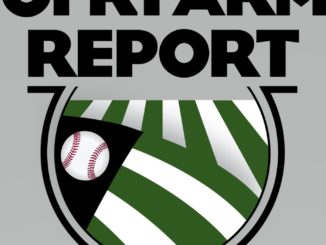
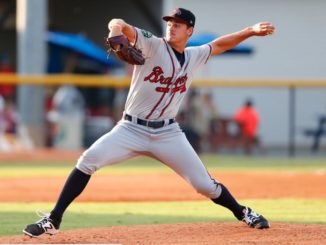
Leave a Reply